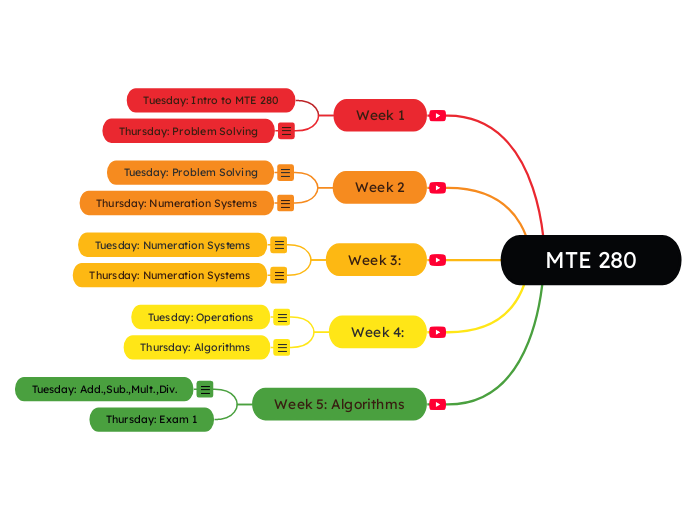MTE 280
Tuesday: Intro to MTE 280
Thursday: Problem Solving
Problems Solving: understanddevise planimplement planPractice Problems: Time and Manipulativeslook back and ask if it is reasonablework backwards
Tuesday: Problem Solving
Problem Solving: George Polya “How to Solve it” understandDevise plan Carry outLook backUse children in practice problem as manipulatives and act the problem out one person cancels out every timefind patterns make combinations organize info to find patterns
Thursday: Numeration Systems
Numeration Systems: A way of recording quantityBase-10 system/decimal systemNumbers get value from the place they sit1-10 relationship between places1-10 relationship is always thereDigits used in Base-10: 0,1,2,3,4,5,6,7,8,9Expanded Notation: 375300+70+5=375 =(3x100)+(7x10)+(5x1)= (3x10^2)+(7x10^1)+(5x10^0)Example:1078 = 1000 + 0 + 70 + 81078 = (1 x 1000) + (0 x 100) + (7 x 10) + (8 x 1)1078= (1 x 1013) + (0x10^2) + (7×1011) + (8 x 1010)Base-5:ones- 5^0fives- 5^125’s- 5^2125’s- 5^3digits used in base-5: 0,1,2,3,4Base-10:ones- 10^0tens- 10^1100’s- 10^21000’s- 10^3practice:111 base 5: (1×5^2) + (1 x511) + (1 x510)111 base 5: (1 x 25) + (1 x 5) + (1 x 1)111 base 5:25 + 5 + 1 = 311023 base 5: (1 x 513) + (0 x 5^2) + (2 x 511) + (3 x 510)1023 base 5: (1 x 125) + (0 x 25) + (2 x 5) + (3 x 1)1023 base 5: 125 + 0 + 10 + 3 = 138practice: 375. 25Related to Money:3 $100 bills7 $10 bills5 $1 bills2 dimes5 pennies (1/10 of a dime)
Tuesday: Numeration Systems
Continuing numeration systemsbase-3: ones- 3^0threes-3^1nines-3^2 27’s-3^3practice:1222 base 3= ((1x3^3)+(2x3^2)+(2x3^1)+(2x3^0)=53 Base 5 Digits Used: 0, 1, 2, 3, 4 Expanded: ones 5^01 1 1 base 5 fives5^1| | ones 25s 5^2 l fives125s5^3 25s111 base 5: (1×5^2) + (1 x511) + (1 x510)111 base 5: (1 x 25) + (1 x 5) + (1 x 1)111 base 5:25 + 5 + 1 = 311023 base 5: (1 x 513) + (0 x 5^2) + (2 x 511) + (3 x 510)1023 base 5: (1 x 125) + (0 x 25) + (2 x 5) + (3 x 1)1023 base 5: 125 + 0 + 10 + 3 = 138Use Manipulatives to help you XX XX XX XXXX XX XX XXXX X
Thursday: Numeration Systems
Continuation numeration systemsbase-2: ones-2^0twos-2^1fours-2^2eights-2^3sixteens-2^4digits: 0,1practice: 1111 base 2= (1x2^3)+(1x2^2)+(1x2^1)+(1x2^0)=15 43 base 3 > 25 base 54 base 5 = 4 base 6111 base 2 = 7100 base 2 < 18 base 9
Tuesday: Operations
Additional meaning and properties Identity: a+o=a *When I add zero to any number, the number does not change Commulative: a+b=b+a *The order does not matter Associative: (a+b)+c = a+(b+c) * the way you group does not matter Subraction:take away 4-3=1comparisonmissing addend as adults, we subtract, as kids, we addMultiplication3x4: 3 groups of 4 3 and 4 are factors ,12 is the product repeated addition: telling timeSKIP countingCartesian product: combining groupsProperties: identity ax1=a when I multiply by one, the identity does not changeCommutative: Order axb=bxa The order in which I multiply does not matterAssociative: grouping (axb)xc=ax(bxc) The way we group the problems is not matter zero: Any number multiplied by zero equals zerodistributive: When I multiply a number by the sum of two other numbers, it is the same as multiplying the number by each addend
Thursday: Algorithms
Division:there are three different signs to divisionThere is a divisor quotient dividend, and remainderLong division algorithm:Teach this when students can explain what they are doing with the method of place values with manipulative. you turn the remaining hundreds into tens and turn the remaining 10’s into 1’sAnd alternative algorithm you can use is by asking yourself how many boxes can fit into the number given
Tuesday: Add.,Sub.,Mult.,Div.
Addition algorithmsAmerican Standardright to leftNo reference to place valueThis is the last stepPartial sumsadd the partial sums with Use of columnsNo reference to place valueRight to leftAdd place value to partial sumstalk about the Values being addedRight to leftReference to place value with columnsLeft to rightsolve the equation from left to right using place valuesexpanded notationuse expanded notation and knowledge of place values to solve equationLattice MethodThe numbers are written in columns to find the final sumSubtraction algorithmsAmerican StandardLeft to rightreverse Indianleft to rightNo reference to place valueleft to rightadd place valueAdjust numbers for borrowingexpanded notationuse expanded notation and knowledge of place values to solve the equationinteger sub algorithmusing integers , Positive and negative numbersuse place valuesMultiplication algorithmsAmerican StandardPlace valueExpanded notationlattice Method
Thursday: Exam 1
